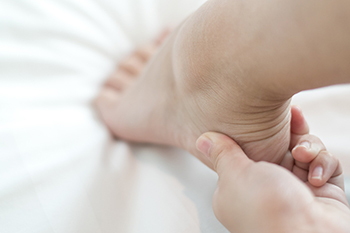 Many people enjoy running, and it can be an important part of achieving fitness goals. Research has shown the significance of stretching and warming up for an adequate amount of time before running is started. This may be helpful in preventing running injuries, such as plantar fasciitis, Achilles tendinitis, and shin splints. Wearing the correct shoes may minimize the chances of getting injured. In addition, getting a physical examination before a running regime is started is a good idea. Many runners identify their running goals, which can help them to gradually increase their mileage and speed. If you would like more information about how running injuries can affect the feet, and how to prevent them, please speak with a podiatrist.
Many people enjoy running, and it can be an important part of achieving fitness goals. Research has shown the significance of stretching and warming up for an adequate amount of time before running is started. This may be helpful in preventing running injuries, such as plantar fasciitis, Achilles tendinitis, and shin splints. Wearing the correct shoes may minimize the chances of getting injured. In addition, getting a physical examination before a running regime is started is a good idea. Many runners identify their running goals, which can help them to gradually increase their mileage and speed. If you would like more information about how running injuries can affect the feet, and how to prevent them, please speak with a podiatrist.
Exercising your feet regularly with the proper foot wear is a great way to prevent injuries. If you have any concerns about your feet, contact one of our podiatrists of Carolina Foot & Ankle Specialists. Our doctors will treat your foot and ankle needs.
How to Prevent Running Injuries
Many common running injuries are caused by overuse and overtraining. When the back of the kneecap starts wearing out and starts causing pain in your knee, this is commonly referred to as runner’s knee. Runner’s knee is a decrease in strength in your quadriceps and can occur if you’re not wearing properly fitted or supporting shoes. To prevent runner’s knee, focusing on hip strengthening is a good idea, as well as strengthening your quads to keep the kneecaps aligned.
What Are Some Causes of Running Injuries?
- One cause of a common running injury is called iliotibial band syndrome.
- Plantar fasciitis is also another common injury.
- Stress fractures can occur from overtraining, lack of calcium, or even your running style.
Best Ways to Prevent Running Injuries
- Wear footwear that fits properly and suits your running needs.
- Running shoes are the only protective gear that runners have to safeguard them from injury.
- Make a training schedule. Adding strengthening exercises as well as regular stretching can help keep you strong and limber and can lessen the possibility of injuries.
- Stretching keeps muscles limber; this will help you gain better flexibility.
If you have any questions please feel free to contact our offices located in Mount Pleasant and Charleston, SC . We offer the newest diagnostic and treatment technologies for all your foot and ankle needs.






